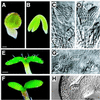LEAFY COTYLEDON2 encodes a B3 domain transcription factor that induces embryo development
- PMID: 11573014
- PMCID: PMC58812
- DOI: 10.1073/pnas.201413498
LEAFY COTYLEDON2 encodes a B3 domain transcription factor that induces embryo development
Abstract
The Arabidopsis LEAFY COTYLEDON2 (LEC2) gene is a central embryonic regulator that serves critical roles both early and late during embryo development. LEC2 is required for the maintenance of suspensor morphology, specification of cotyledon identity, progression through the maturation phase, and suppression of premature germination. We cloned the LEC2 gene on the basis of its chromosomal position and showed that the predicted polypeptide contains a B3 domain, a DNA-binding motif unique to plants that is characteristic of several transcription factors. We showed that LEC2 RNA accumulates primarily during seed development, consistent with our finding that LEC2 shares greatest similarity with the B3 domain transcription factors that act primarily in developing seeds, VIVIPAROUS1/ABA INSENSITIVE3 and FUSCA3. Ectopic, postembryonic expression of LEC2 in transgenic plants induces the formation of somatic embryos and other organ-like structures and often confers embryonic characteristics to seedlings. Together, these results suggest that LEC2 is a transcriptional regulator that establishes a cellular environment sufficient to initiate embryo development.
Figures






References
MeSH terms
Substances
Associated data
- Actions
- Actions
LinkOut - more resources
Full Text Sources
Other Literature Sources
Molecular Biology Databases

